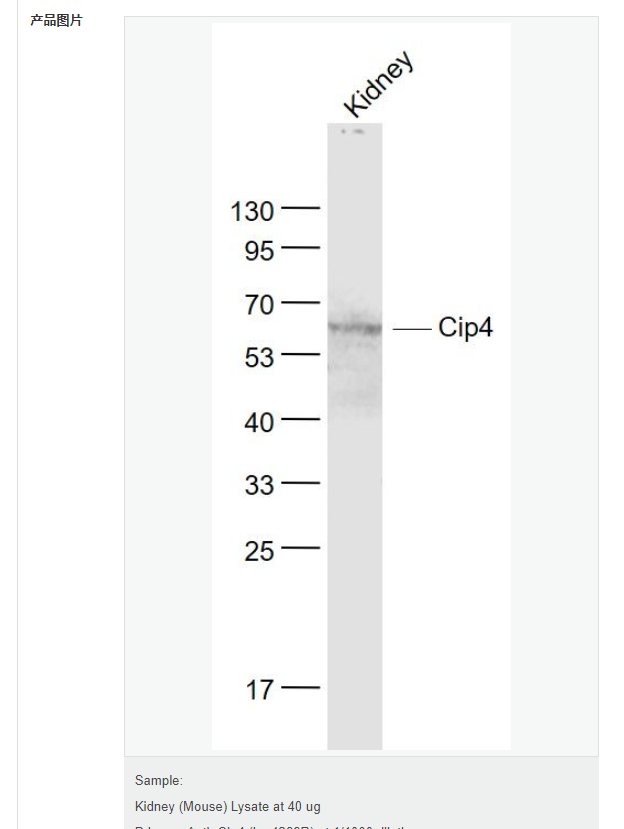

貨號
產(chǎn)品規(guī)格
售價
備注
BN41009R-100ul
100ul
¥2360.00
交叉反應(yīng):Mouse(predicted:Human,Rat,Dog,Pig,Cow,Horse) 推薦應(yīng)用:WB,ELISA
BN41009R-200ul
200ul
¥3490.00
交叉反應(yīng):Mouse(predicted:Human,Rat,Dog,Pig,Cow,Horse) 推薦應(yīng)用:WB,ELISA
產(chǎn)品描述
| 英文名稱 | Cip4 |
| 中文名稱 | 細胞分化周期CDC42相互作用蛋白4抗體 |
| 別 名 | Cdc42 interacting protein 4; Cdc42 interaction protein 4 long isoform; Cdc42-interacting protein 4; Cip 4; CIP4_HUMAN; DCIP4; hSTP; Protein Felic; Salt tolerant protein; Salt tolerator; STOT; STP; Thyroid hormone receptor interactor 10; Thyroid receptor interacting protein 10; Thyroid receptor-interacting protein 10; TR-interacting protein 10; TRIP 10; TRIP-10; trip10; Truncated Cdc42 interaction protein 4. |
| 研究領(lǐng)域 | 腫瘤 細胞生物 免疫學(xué) 染色質(zhì)和核信號 信號轉(zhuǎn)導(dǎo) 細胞周期蛋白 |
| 抗體來源 | Rabbit |
| 克隆類型 | Polyclonal |
| 交叉反應(yīng) | Mouse, (predicted: Human, Rat, Dog, Pig, Cow, Horse, ) |
| 產(chǎn)品應(yīng)用 | WB=1:500-2000 ELISA=1:5000-10000 not yet tested in other applications. optimal dilutions/concentrations should be determined by the end user. |
| 分 子 量 | 66kDa |
| 細胞定位 | 細胞漿 細胞膜 |
| 性 狀 | Liquid |
| 濃 度 | 1mg/ml |
| 免 疫 原 | KLH conjugated synthetic peptide derived from human Cip4:151-250/601 |
| 亞 型 | IgG |
| 純化方法 | affinity purified by Protein A |
| 儲 存 液 | 0.01M TBS(pH7.4) with 1% BSA, 0.03% Proclin300 and 50% Glycerol. |
| 保存條件 | Shipped at 4℃. Store at -20 °C for one year. Avoid repeated freeze/thaw cycles. |
| PubMed | PubMed |
| 產(chǎn)品介紹 | Required for translocation of GLUT4 to the plasma membrane in response to insulin signaling (By similarity). Required to coordinate membrane tubulation with reorganization of the actin cytoskeleton during endocytosis. Binds to lipids such as phosphatidylinositol 4,5-bisphosphate and phosphatidylserine and promotes membrane invagination and the formation of tubules. Also promotes CDC42-induced actin polymerization by recruiting WASL/N-WASP which in turn activates the Arp2/3 complex. Actin polymerization may promote the fission of membrane tubules to form endocytic vesicles. Required for the formation of podosomes, actin-rich adhesion structures specific to monocyte-derived cells. May be required for the lysosomal retention of FASLG/FASL. Function: Required for translocation of GLUT4 to the plasma membrane in response to insulin signaling (By similarity). Required to coordinate membrane tubulation with reorganization of the actin cytoskeleton during endocytosis. Binds to lipids such as phosphatidylinositol 4,5-bisphosphate and phosphatidylserine and promotes membrane invagination and the formation of tubules. Also promotes CDC42-induced actin polymerization by recruiting WASL/N-WASP which in turn activates the Arp2/3 complex. Actin polymerization may promote the fission of membrane tubules to form endocytic vesicles. Required for the formation of podosomes, actin-rich adhesion structures specific to monocyte-derived cells. May be required for the lysosomal retention of FASLG/FASL. Subunit: Interacts specifically with GTP-bound RHOQ. Interacts with DNM2 and PDE6G (By similarity). Homodimerizes, the dimers can polymerize end-to-end to form filamentous structures. Interacts specifically with GTP-bound CDC42. Interacts with AKAP9, ARHGAP17, DAAM1, DIAPH1, DIAPH2, DNM1, FASLG/FASL, GAPVD1, LYN, microtubules, SRC, WAS/WASP and WASL/N-WASP. Interacts with the ligand binding domain of the thyroid receptor (TR) in the presence of thyroid hormone. May interact with CTNNB1 and HD/HTT. Subcellular Location: Cytoplasm, cytoskeleton. Cytoplasm, cell cortex. Lysosome. Golgi apparatus. Cell membrane. Cell projection, phagocytic cup. Note=Translocates to the plasma membrane in response to insulin stimulation, and this may require active RHOQ (By similarity). Localizes to cortical regions coincident with F-actin, to lysosomes and to sites of phagocytosis in macrophages. Also localizes to the Golgi, and this requires AKAP9. Isoform 5: Cytoplasm, perinuclear region. Tissue Specificity: Expressed in brain, colon, heart, kidney, liver, lung, megakaryocyte, ovary, pancreas, peripheral blood lymphocytes, placenta, prostate, skeletal muscle, small intestine, spleen, testis, thymus and trachea. Post-translational modifications: Tyrosine phosphorylated. Also phosphorylated by PKA. Similarity: Belongs to the FNBP1 family. Contains 1 FCH domain. Contains 1 REM (Hr1) repeat. Contains 1 SH3 domain. SWISS: Q15642 Gene ID: 9322 Database links: Entrez Gene: 9322 Human Entrez Gene: 106628 Mouse Omim: 604504 Human SwissProt: Q15642 Human SwissProt: Q8CJ53 Mouse Unigene: 515094 Human Unigene: 37368 Mouse Unigene: 10814 Rat Important Note: This product as supplied is intended for research use only, not for use in human, therapeutic or diagnostic applications. |
